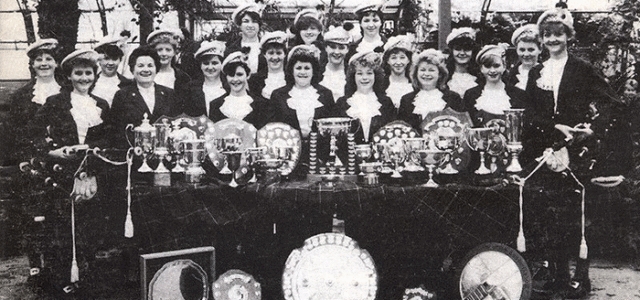
By Jeannie Campbell
The South London Girl Pipers were listed among the new bands joining the SPBA in 1961. The Belfast Girls’ Pipe Band and the Faulat Girls’ band were mentioned as playing at events in Northern Ireland that same year. The Deeside Ladies (pictured above) were probably the most successful ladies band ever. The band was founded in 1964 and started off in Grade 4. In 1981 they were Champions of Champions in that grade and were promoted to Grade 3.
In 1986 they were the Champions of Champions in Grade 3, winning all five majors, and were promoted to Grade 2 for 1987 when they continued their success by winning the Cowal Championship, coming third in the Worlds, fourth in the British and sixth in the European, under P/M Fiona Cruickshank and Leading Drummer Alison Savage.
No other ladies band had reached this level of competition success before and if the band had not suffered a loss of personnel they would probably have become the first ladies’ band to compete in Grade One. The band wore Ancient Green Douglas tartan, with light blue jackets and white balmorals.
Bands competing in Scotland during the 1968 season were Aberdeen Ladies, Deeside Ladies, Maclean Ladies, Caledonia Ladies and Winnipeg Heather Belle, who all played in Grade 4. Separate events for girls’ bands were held in Canada too. Results from 1968 show Toronto Girls and Glengarry Girls winning prizes.
This letter, written under a pseudonym, appeared in Pipe Band Magazine in 1969: ‘Being a fond admirer of the fair sex I never cease to be amazed, and appalled, that any group of charming young ladies should feel it incumbent on themselves to disguise themselves as men, under the mistaken impression that they will thus better look the part of a band.
‘That they should think this is unfortunate. That they succeed is a tragedy. How any young lady in this day and age can be content to cram her crowning glory under a big feather bonnet or encase her legs in hairy stockings and gaiters instead of nylons is beyond me. I, and I am sure a great many other men, prefer my women to look like women, not like oddly shaped wee fellas.’
On the subject of the dress of female pipers, the editor of the Piping Times wrote in 1957: ‘Regarding the contention that girls appear in male attire at piping competitions, surely this is the fault of the organisers of contests, who stipulate the dress to be worn by competitors.
‘Most girls, I am sure, would prefer to look their best in a properly tailored skirt, and it might be an idea to have ladies’ bands so attired at future competitions. Perhaps the SPBA could take the bold step here.’
‘Concerning dress, it cannot be denied that women are shaped differently from men, but often a woman joining a band will be kitted out in a uniform which has been made to measure previously for a male member of the band. A full dress doublet, with plaid, cross belt one waist belt is uncomfortable to wear and does not sit right unless the chest beneath it is flat.’
In 1969 an FC MacColl Botly wrote to the Piping Times. He had been in charge of the piping competitions White City, llford, Egham, Edmonton and Harpenden, all in the south of England, for over 16 years and had always barred female pipers and mixed bands.
He described this as a pro-feminine decision because: ‘Female fingers and musical intuition is quite different from that of men, unless the woman is really masculine, or trying to be. The woman player is inclined to be far more correct in her fingering, more delicate, more accurate, plays according to the book.
‘The male approach to music is, or should be, different . He has fists and fingers and a masculine mind. Women pipers can, in their own field, be quite competent and a pleasure to listen to, but there is no common ground with men. To try to equate the two in a so-called competition is a lowering of standards and a reflection upon the judge’s knowledge and competence.
‘At the moment women pipers and drummers are encouraged to dress as men, to ape men, to take the mickey. In fact they only make themselves ridiculous and bring contempt upon a noble tradition. It is no good for Scotland to tolerate this farce and then to complain about her music hall tartan image.
‘It is the public responsibility of competition and games organisers to so direct their own ethical standards that women are encouraged to become ladies, and men, gentlemen. This is what happened to a large degree in the south. The same result could occur in Scotland, under proper leadership.’
Many letters in support of lady pipers followed and probably this directive from the south encouraged Scottish promoters to allow ladies to compete in their events. Mr Botly had one supporter, another Londoner, who wrote: ‘The reason that many competitions are for males only is because it is a man’s instrument, although hundreds of women play it, some far better than I ever shall.
‘But it is like a woman smoking a pipe; it just does not look right. Perhaps you can imagine what an old woman would look like playing the pipes? I hate to see women wearing a travesty of the man’s dress, e.g. kilts, sporrans, spats etc. Aboyne will not allow it and I hope that other gatherings will follow suit. Women, when looking like women are wonderful, but laughable when imitating a man. How much nicer she looks when looking like a real woman should.’
The Vancouver Ladies’ Pipe Band visited Scotland and competed during the 1969 season. At the end of the visit it was reported that their Pipe Major, Rae-Marie MacAuley had defected to the East. In fact her husband had gained an appointment at the Dounreay atomic plan in Caithness so the couple were staying in Scotiand.
The separate competitions for ladies’ bands were discontinued by 1971 when Grades 4 and Novice Juvenile were established. A separate prize for the best ladies’ band in each grade was introduced at the major competitions but this too was discontinued in 1987.
The Hawick Girls’ Brigade Pipe Band was founded in 1972. They competed in the Novice Juvenile grade. In Aberdeen the Heatherdale Ladies’ Band was founded in 1972. One of their helpers, Bill Morrison, tuned the pipes on practice nights and made cane trays and pictures, which were sold to raise funds. Bill had been a piper for 20 years and although blind had agreed to help the ladies. The band were placed in Grade 3 for the 1973 season.
Another new band that season, Edinburgh and Leith Girls, were placed in Grade 4. In Eire the St Louise Girls’ Pipe Band was formed in Ballyfermot and made several appearances during the 1973 season. The Blessed Oliver Plunkett Girls’ Pipe Band, from Munster, was competing during the 1972 season and visited Holland in 1973.
Although women were not allowed play at some of the top solo events such as the Argyllshire Gathering or the Northern Meeting until 1976 when the Sex Discrimination Act came into force. Women were, however, allowed to play a other professional solo competitions such as the Scottish Pipers’ Association and the Uist and Barra.
Competitors at these events in the 1970s included Jennifer Hutcheon, Anne Sinclair (later Mrs Johnston), Patricia Innes (later Mrs Henderson), and Anne Stewart (later Mrs Spalding). By the late 1970s and early 1980s they had been joined by Anne Marie Maclellan, Catherine MacInnes, Mary MacNeill, Annie Grant, Christine MacNeill, Fiona Anderson, Elaine Marnoch, Janice Milne, Amy Goble (Garson), Ann MacKay and others.
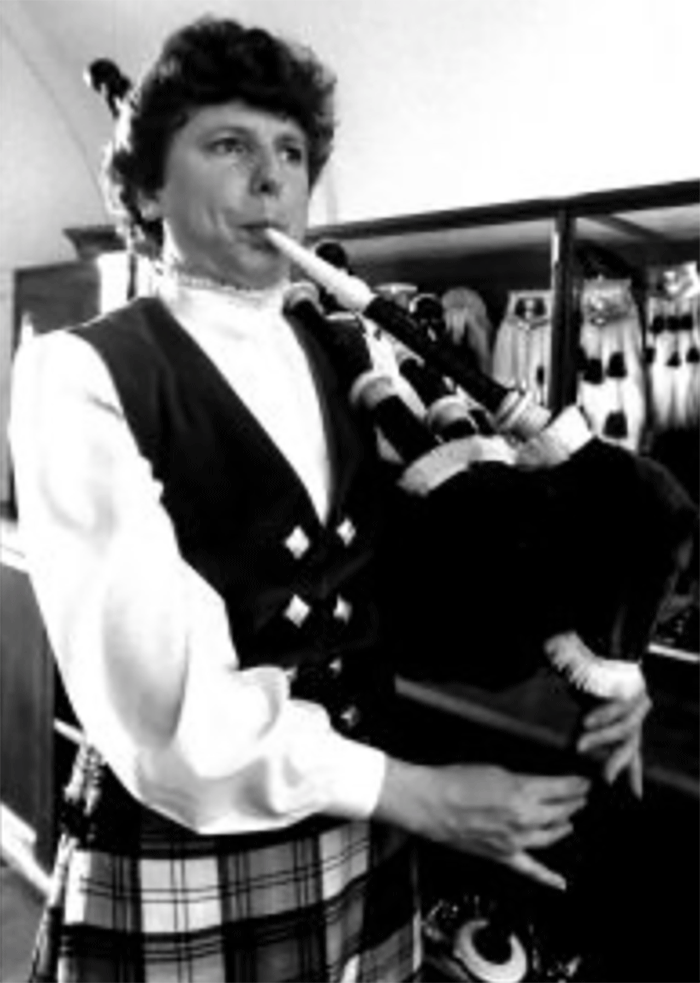
Several of these girls had played in ladies’ bands. Anne Stewart, from Carnoustie, was the daughter of Reta Stewart, P/M of the Maclean Ladies, and had been a piper from the age of seven.
Patricia Innes, from Aberdeen, began her piping career aged nine, having previously tried Highland dancing. She played with Bon Accord and Deeside Ladies. Elaine Marnoch too came from Aberdeen. She began piping aged seven and had played with Bon Accord and Deeside Ladies.
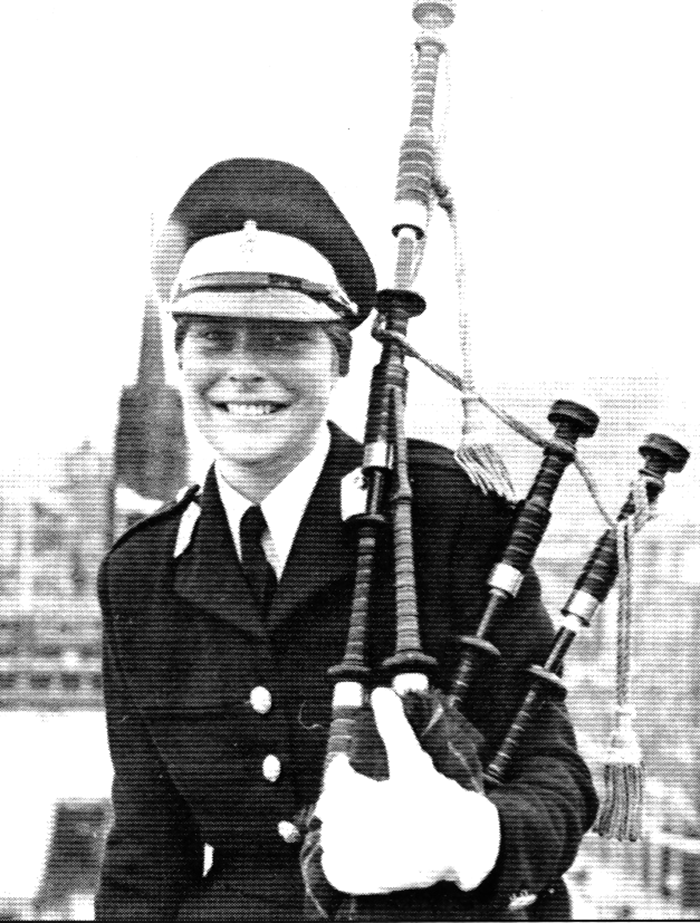
As a student she joined the Aberdeen University OTC Pipe Band and became not only the first girl to play at the Edinburgh Military Tattoo in 1977 but also the only girl ever to appear as the lone piper on the ramparts of Edinburgh Castle.
Annie Grant was the tutor and Pipe Major of the Dunoon Grammar School pipe band and before retiring was an RSPBA adjudicator. In 2005 she was awarded the Balvenie Medal for services to piping. Anne Sinclair came from a Tiree family of pipers. She played with British Caledonian Airways in the 1970s and was pictured on the cover of their 1976 LP, but was forced to leave the band when a new pipe major took over in 1977. She married drummer Tommy Johnston and is the mother of piper Finlay Johnston.
Ladies’ bands, which competed in major competitions in Scotland during the 1970s, were Rose Fletcher, Maclean, Bon Accord, Deeside, Heatherdale and Aberdeen Ladies, Ladies from Vancouver.
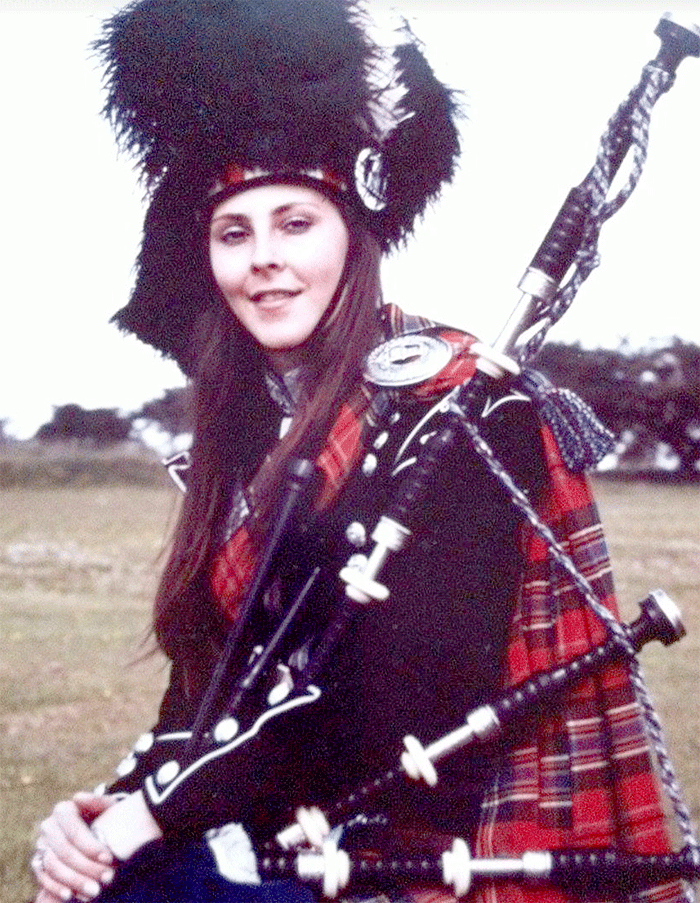
Gail Brown was the first woman to play in a Grade One World Championship winning band when she took the field with Shotts and Dykehead in 1973. Soon after this Jennifer Hutcheon from Edinburgh joined the Red Hackle band and later played with Shotts when they won the Worlds in 1980. Jennifer had many years of success as tutor and pipe major of the Craigmount High School Pipe Band and was piping tutor at Strathallan School.
Bands competing at majors in the 1980s were Aberdeen, Vancouver, Fraser, Maclean, Bon Accord, Deeside and Winnipeg Heather-Belle Ladies, Georgetown Girls and the Presbyterian Ladies College.
By this time it was normal for women to play in mixed sex bands so there was no longer a need for ladies’ bands. Pipe bands of all grades today have women playing in their ranks and no distinctions are made on the grounds of sex. Things have come a long way since the early days and women are now taking their place alongside the men at the forefront of pipe bands around the world.
- Have you enjoyed this series? Do you have a story to tell regarding lady pipers? Share your story by emailing us.








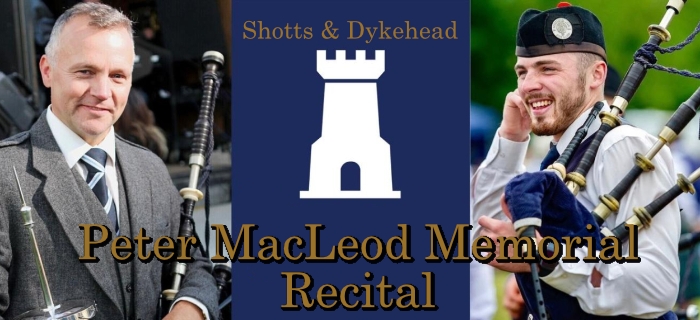







Is this the Lily Christie of the terrific 6/8 by Donald Shaw Ramsay?
Lily Christie was the wife of P/M Jim Christie of Wick – another great tune. She was an amazing lady who made many of the uniforms for the Wick Girls Pipe Band when they started out back in 1946.
Thanks, Grace. It’s great to know who Lily Christie was after over 50 years. I first heard her tune on the famous Invergordon Distillery PB LP of the mid-60s. I was so impressed I duly learned it and have been playing it ever since. It was added to the repertoire of the band I was in at the time, 1st Port Glasgow BB. Incidentally we won the World Juvenile Championships at Hawick in 1972 pushing our great rivals, the 214 Glasgow BB, into second place. Happy days!
It was so nice to see Wick Girls Pipe Band, PM Jim Christie and Mrs. Lily Christie mentioned in this article. It was with Jim Christie that I started piping at the age of 9. One thing the article did not mention was that the band won The Scottish Ladies Championship in Edinburgh in 1958 and 1962.